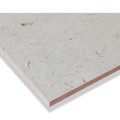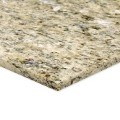Marble Tile Glossary
Whether you love it on the floor, on the wall, or in your shower, marble tile brings a sense of elegance and timelessness to any space. The variety of colors, sizes, and patterns makes marble a go-to material for all areas of your home. Check out the below glossary of terms to learn more about this beautiful natural stone.

A marble tile accent wall will add lasting elegance to your interior decor. (Pedra Marble Tile – Polished Branco Select)
Accent tile: A secondary tile used to decorate and bring out the qualities of the field tile. An inlay, for instance, might show off marble tile mosaics in a checkered or repeating pattern.
Artificial marble: Also known as cultured or reconstituted marble, this engineered product is made from a combination of stone particles and synthetic resins, which are cast and designed to look like authentic marble.
Bullnose: A piece of marble that has a convex or rounded edge. This edge type is used for stair treads, countertop edges, and trim.
Carrara: One of the most popular types of marble for sculpture and building décor. Carrara marble is usually white, gray, or blue-gray, and features linear vein patterns.
Caulk: Generally silicone based, this material is used to seal joints between tiles and other surfaces.
Coefficient of friction: A calculation used to measure tile’s smoothness or slip-resistance. Textured marble is more slip-resistant than high-gloss tile.
Cure time: The time required for an adhesive to dry and set completely. For example, when installing marble tile you must wait for the grout to cure before you can seal it.
Field tile: The tile material chosen to cover most of a space, such as a floor. Accent tiles can be used for borders, mosaics, and other creative designs.
Grout: A thin mortar that’s used to fill the joints between marble tiles. For joints 1/8” or smaller, use unsanded grout; sanded grout is commonly used for joints 1/8” or larger. Sanded grout can scratch polished marble, so install this type of tile with unsanded grout and joint widths smaller than 1/8”.
Honed: A marble surface finish that produces a satin or matte (and not glossy) look and feel.
Large-format tile: A tile is deemed large format when at least one of its edges is longer that 15”. Large-format marble tile options include 12”x24”, 18”x18”, and 24”x24”.
Listello: Border tiles used to enhance a wall or other field.
Marble: A metamorphic rock formed when limestone is exposed to intense heat and pressure. Other minerals present in the limestone, like clay, sand, or silt, give marble its characteristic vein patterns. It takes polish well.
Molding (trim): Decorative edging applied to a marble tile field. Sometimes molding hides spaces between tiles and other flooring materials or between floors and walls.
Mosaic: A decorative design element/pattern created with small tiles in a specific area of a floor or wall.
Polished: A smooth surface finish that gives marble tile high reflectivity and a glossy sheen.
Porosity: The number of tiny holes on a surface that allow liquids to absorb into the material. All natural stone is porous to some extent; polished marble is less porous than other finishes, making it less vulnerable to absorbing liquids.
Sealer: A protective, topical coating applied to natural stone tiles to prevent liquids or other materials from absorbing into the surface. This will protect the stone from staining.
Spacer (shim): A cross-shaped piece of plastic or rubber used during installation to create the grouted space between marble tiles.
Thinset mortar: A blend of cement, fine sand, and water retention compounds used to adhere tiles to a substrate.
Variation: The changes in color and tone that occur on a piece (or multiple pieces) of marble tile.
Veining: The lines of color that run through the marble’s dominant color.
What else do you want to learn about marble tile? Let us know in the comments.
Browse our selection of beautiful Marble Tile here.



